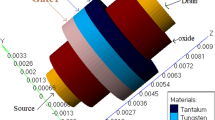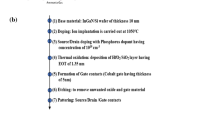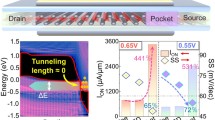Abstract
The present paper has proposed a dielectric modulated gate underlap dopingless tunnel field effect transistor (DM-GUD-TFET). In the proposed device, a cavity is introduced on side of the gate metal to attain high sensitivity for biomedical applications. The immobilization of biomolecules within the cavity induces the variation in surface potential. The present work has analyzed different parameters affecting the electrical characteristics of the device which include a change in spacer length, variation in applied voltages (Vds and Vgs), and channel material. The modeling output characteristics have been compared with simulated outcomes for validating results. The potential model is obtained by categorizing the structure into ten sections counting source-drain depleted sections. The surface potential of each section is resolved using 1-dimennsional and 2-dimensional Poisson’s eq. (P.Eq.), respectively. The different values of dielectric constant and charge density are used for recreating the biomolecules for simulation in Silvaco ATLAS tool.
Similar content being viewed by others
References
Malhotra BD, Kumar S, Pandey CM (2016) Nanomaterials based biosensors for cancer biomarker detection. J Phys Conf Ser 704(1):1–11. https://doi.org/10.1088/1742-6596/704/1/012011
Shin J, Choi S, Yang J-S, Song J, Choi J-S, Jung H-I Smart forensic phone: Colorimetric analysis of a bloodstain for age estimation using a smartphone. Sensors Actuators B Chem 243:221–225. https://doi.org/10.1016/j.snb.2016.11.142
Bergveld P (2003) Thirty years of ISFETOLOGY: What happened in the past 30 years and what may happen in the next 30 years. Sensors Actuators B Chem 88(1):1–20. https://doi.org/10.1016/S0925-4005(02)00301-5
Tavakoli J, Tang Y Honey/PVA hybrid wound dressings with controlled release of antibiotics: Structural, physico-mechanical and in-vitro biomedical studies. Mater Sci Eng C 77(1):318–325. https://doi.org/10.1016/j.msec.2017.03.272
Stern E, Klemic JF, Routenberg DA, Wyrembak PN, Turner-Evans DB, Hamilton AD, LaVan DA, Fahmy TM, Reed MA Label-free immune detection with CMOS-compatible semiconducting nanowires. Nat 445(7127):519–522. https://doi.org/10.1038/nature05498
Narang R, Reddy KVS, Saxena M, Gupta RS, Gupta M (2012) A dielectric-modulated tunnel-FET-based biosensor for label-free detection: analytical modeling study and sensitivity analysis. IEEE Transaction on Electron Devices 59(10):2809–2817. https://doi.org/10.1109/TED.2012.2208115
Chen X, Guo Z, Yang GM, Li J, Li MQ, Liu JH, Huang XJ (2010) Electrical nanogap devices for biosensing. Mater Today 13(11):28–41. https://doi.org/10.1016/S1369-7021(10)70201-7
Choi J-M, Han J-W, Choi S-J, Choi Y-K (2010) Analytical modelingof a nanogap-embedded FET for application as a biosensor. IEEE Transactions Electron Devices 57(12):3477–3484. https://doi.org/10.1109/TED.2010.2076152
Chen X, Liu Y, Huang J, Liu W, Huang J, Zhang Y, Fu W (2017) Label-free techniques for laboratory medicine applications. Front Lab Med 1(2):82–85. https://doi.org/10.1016/j.flm.2017.06.003
Poghossian A, Schöning MJ (2014) Label-Free Sensing of Biomolecules with Field-Effect Devices for Clinical Applications. Electroanalysis 26:1197–1213. https://doi.org/10.1002/elan.201400073
Wadhwa G, Raj B (2018) Label free detection of biomolecules using charge-plasma-based gate Underlap dielectric modulated Junctionless TFET. J Electron Mater Springer 47(08):4883–4893
Chanda M, Das R, Kundu A, Sarkar CK (2017) Analytical modeling of label free biosensor using charge plasma based gate underlap dielectric modulated MOSFET. Superlattice Microst 104:451–460. https://doi.org/10.1016/j.spmi.2017.03.010
Wadhwa G, Raj B (2019) Design, simulation and performance analysis of JLTFET biosensor for high sensitivity. IEEE Trans Nanotechnol 18:567–574. https://doi.org/10.1109/TNANO.2019.2918192
GirishWadhwa BR (2018) Parametric variation analysis of symmetric double gate charge plasma JLTFET for biosensor application. IEEE Sensors J 18(15):6070–6077
Kumar MJ, Janardhanan S (2013) Doping-less tunnel field effect transistor: design and investigation. IEEE Trans Electron Devices 60(10):3285–3290
Narang R, Saxena M, Gupta RS, Gupta M (2012) Dielectric modulated tunnel field-effect transistor—A biomolecule sensor. IEEE Electron Device Lett 33(2):266–268
Narang R, Saxena M, M., & Gupta, M. (2015) Analysis of gate underlap channel double gate MOS transistor for electrical detection of bio-molecules. Superlattice Microst 88:225–243
Singh A, Narang R, Gupta M, Saxena M (2013) Investigation of dielectric-modulated double-gate junctionless MOSFET for detection of biomolecules. Annu IEEE India Conf (INDICON). https://doi.org/10.1109/INDCON.2013.6725863
Zhang L, Ma C, He J, Lin X, Chan M (2010) Analytical solution ofrrr subthreshold channel potential of gate underlap cylindrical gate-all around MOSFET. Solid State Electron 54(8):806–808. https://doi.org/10.1016/j.sse.2010.03.020
Vaddi R, Agarwal RP, Dasgupta S (2011) Analytical modeling of subthreshold current and subthreshold swing of an underlap DGMOSFET with tied–independent gate and symmetric–asymmetric options. Microelectron J 42(5):798–807. https://doi.org/10.1016/j.mejo.2011.01.004
Im H, Huang X-J, Gu B, Choi Y-K (2007) A dielectric-modulated field-effect transistor for biosensing. Nat Nanotechnol 2(7):430–434
Xu P, Lou H, Zhang L, Yu Z, Lin X (2017) Compact model for double-gate tunnel FETs with gate–drain Underlap. IEEE Trans Electron Devices 64(12):5242–5248. https://doi.org/10.1109/TED.2017.2762861
Lee MJ, Choi WY (2011) Analytical model of single-gate silicon-on insulator (SOI) tunneling field-effect transistors (TFETs). Solid State Electron 63(1):110–114
Wan J, Le Royer C, Zaslavsky A, Cristoloveanu S (2011) A tunneling field effect transistor model combining interband tunneling with channel transport. J Appl Phys 110(10):104503–1–104503-7
Shen C, Ong SL, Heng CH, Samudra G, Yeo YC (2008) A variational approach to the two-dimensional nonlinear poisson’s equation for the modeling of tunneling transistors. IEEE Electron Device Lett 29(11):1252–1255. https://doi.org/10.1109/LED.2008.2005517
W. G. Vandenberghe, A. S. Verhulst, G. Groeseneken, B. Soree, and W. Magnus (2008) Analytical model for a tunnel field-effect transistor in Proc. MELECON, pp. 923–928, doi: https://doi.org/10.1109/MELCON.2008.4618555
ATLAS (2016) Device simulation software. Silvaco Int, Santa Clara, CA
Gholizadeh M, Hosseini SE (2014) A 2-D analytical model for double gate tunnel FETs. IEEE Trans Electron Devices 61(5):1494–1500. https://doi.org/10.1109/TED.2014.2313037
Wu C, Huang R, Huang Q, Wang C, Wang J, Wang Y (2014) An analytical surface potential model accounting for the dual-modulation effects in tunnel FETs. IEEE Trans Electron Devices 61(8):2690–2696. https://doi.org/10.1109/TED.2014.2329372
Choi J-M, Han J-W, Choi S-J, Choi Y-K Analytical modeling of a nanogap-embedded FET for application as a biosensor, IEEE Transaction Electron Device, vol. 57, no. 12, pp. 3477–3484, Dec. 2010.Rakhi Narang, Manoj Saxena, and Mridula Gupta, "Comparative Analysis of Dielectric-Modulated FET and TFET-Based Biosensor" IEEE Transactions on Nanotechnology, vol. 14, no. 3, pp. 427–435, May 2015
Availability of Data and Material
Not applicable
Author information
Authors and Affiliations
Contributions
All authors contributed to the design and simulation. Material preparation, data collection and analysis were performed by Girish Wadhwa and Balwinder Raj. The first draft of the manuscript was written by Girish Wadhwa and other author commented on previous versions of the manuscript. All authors read and approved the final manuscript.
Corresponding author
Ethics declarations
Conflict of Interest
The authors have declared that no competing interests exist.
Code Availability
Not applicable
Additional information
Publisher’s Note
Springer Nature remains neutral with regard to jurisdictional claims in published maps and institutional affiliations.
Rights and permissions
About this article
Cite this article
Wadhwa, G., Raj, B. Surface Potential Modeling and Simulation Analysis of Dopingless TFET Biosensor. Silicon 14, 2147–2156 (2022). https://doi.org/10.1007/s12633-021-01011-9
Received:
Accepted:
Published:
Issue Date:
DOI: https://doi.org/10.1007/s12633-021-01011-9




